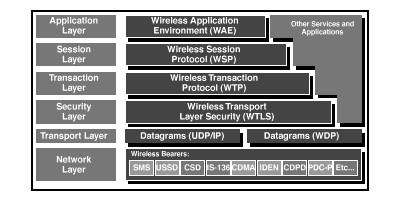
Principal, Xamax Consultancy Pty Ltd, Canberra
Visiting Fellow, Department of Computer Science, Australian National University
Version of 3 February 2000
© Xamax Consultancy Pty Ltd, 2000
This document is at http://www.anu.edu.au/people/Roger.Clarke/II/WAPIntro.html
This document provides introductory information on WAP. Stewart Fist provided an introduction in The Australian's Computer Pages on 1 Feb 2000.
The Wireless Application Protocol (WAP) is a means whereby devices that are communicating by means of wireless channels can transmit data. It assumes the availability of low-level protocols, and is designed to enable applications such as email and the web to be delivered over wireless channels in a manner as compatible as practicable with existing applications that were designed to work over cable-based connections.
In terms of the layers of the Internet Protocol Suite, WAP is a stack of protocols that roughly corresponds to the 'Application' Layer, and HTTP, SMTP and FTP and related standards. It specifies translations to and from HTTP; but, unlike HTTP, WAP is 'stateful'.
The WAP family of standards includes an XML-derived markup language called Wireless Markup Language (WML), and WMLScript (cf. Javascript), which reflect the constraints of handheld devices. They do not assume that a QWERTY keyboard or a mouse are available for user input, and are designed for small screen displays. It also includes a specification for a microbrowser designed to run in a wireless remote device, which controls the user interface and is analogous to a Web browser. It pays particular attention to security matters.
The protocol stack is as follows:

The specification has been developed by the WAP Forum, who provide an (only semi-helpful) introduction. WAP.net provides a more useful FAQ and some demonstration applications.
They also provide a 122K, 22-page PDF white paper, specifications, and presentations.
A substantial set of resources is provided by Robin Cover at OASIS.
Considerable concern has been voiced by Rohit Khare.
ETC's Ooi Chuin Nee argues that WAP has reinvented the wheel when they could have defined subsets of the equivalent, pre-existing protocols. Mobile devices currently have relatively low processing power compared with desk-based computers, and their use has to confront other limitations such as smaller displays, non-colour displays (or no displays at all, e.g. on phone devices), limited keyboards (or none at all), lower bandwidth, and more line-dropout. So it makes sense to strip down the functionality of the protocols. But the approach adopted has created unnecessary incompatibilities with existing Internet protocols.
W3C has been working on Mobile Access for some time. It is conducting a polite dialogue with the WAP Forum ...
A large group of interested parties has developed a set of protocols intended to support Internet-related communications over wireless channels. They have done so with limited attention to the established IETF and W3C fora, and the standards embody divergences from and hence incompatibilities with existing standards. It remains to be seen whether the standards will be effective.
Most of this was provided by my ETC colleagues, Mark Nearhos and Ooi Chuin Nee.
Go to Roger's Home Page.
Go to the contents-page for this segment.
Created: 31 January 2000
Last Amended: 3 February 2000
 | These community service pages are a joint offering of the Australian National University (which provides the infrastructure), and Roger Clarke (who provides the content). |  |
| The Australian National University Visiting Fellow, Faculty of Engineering and Information Technology, Information Sciences Building Room 211 | Xamax Consultancy
Pty Ltd, ACN: 002 360 456 78 Sidaway St Chapman ACT 2611 AUSTRALIA Tel: +61 2 6288 1472, 6288 6916 |